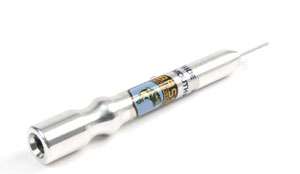
It’s a technique every structure fisherman should know. If you bring up a bass from 20 feet deep or more, odds are that the pressure change will cause the fish’s swim bladder to inflate, preventing the fish from swimming upright and, in some cases, from returning to the depth at which it was caught. To ensure survival of these fish, “fizzing” is necessary.
The process entails inserting a needle through the side of the fish and into the swim bladder to release air. For years, anglers have used hypodermic needles to fizz their fish. But now, there’s a better way. BASS has collaborated with Team Marine USA of Tampa, Fla., to create a much safer and more effective fizzing tool: the BASS Pro Fizz FZ-1.
The FZ-1 is built specifically for freshwater species, and BASS Conservation Director Chris Horton offered his input to Team Marine USA during development of the FZ-1. The FZ-1 is similar to Team Marine’s saltwater fizzers, but it’s modified for freshwater use. “The FZ-1 is the right tool for bass because it has an 18-gauge needle,” said Horton.
“Many of the other fizzers you see are for saltwater fish and are too big. If you fizz a bass with anything bigger, you may do more harm than good. The FZ-1 is also much safer than keeping a hypodermic needle rolling around in your boat.” The tool has a retractable needle that’s spring-loaded to keep it from accidentally deploying and sticking something other than a fish. The FZ-1 has made fizzing safer for the bass as well. Rather than punching a hole in your fish, the FZ-1 leaves a C-shaped incision.
The incision creates a “flap,” which heals quicker and better than a hole punched by a hypodermic needle. The FZ-1 also features two different settings, depending on where you plan on fizzing the fish. For mouth fizzing, use the shorter setting; extend the needle completely for side fizzing. “If you’re an inexperienced fizzer, going through the side is going to be easiest,” Horton said.
“The key — whether you’re fizzing from the side or the mouth — is to submerge the fish. That way, as you insert the needle you can tell when you’ve entered the swim bladder. Once you have, bubbles will come out.” Horton said fizzing is needed most during summer and winter, when bass are more likely to be caught deep because of their seasonal patterns.
Some fish will be able to return to deep water if released immediately, but those kept in a livewell definitely need attention. “Check a deepwater fish 15 minutes after putting it into your livewell,” Horton suggested. “If the fish is floating rather than swimming, has air bubbles in its eyes, or has a knot on its side, you need to fizz it to give it a better chance of survival.
The FZ-1 is the best tool for the job,” Horton explained.
| |
For more great stories and the latest bass fishing news, subscribe to BASS Times. Call 877-BASS-USA to order today. |




